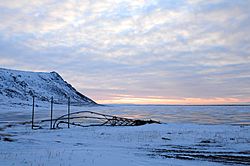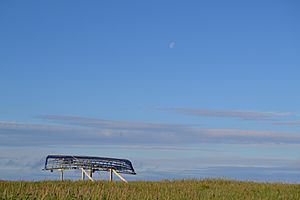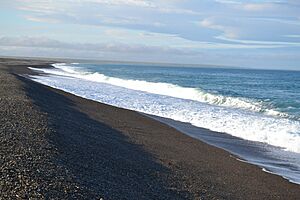Gambell, Alaska facts for kids
Quick facts for kids
Gambell
Sivuqaq (Central Siberian Yupik)
|
|
|---|---|
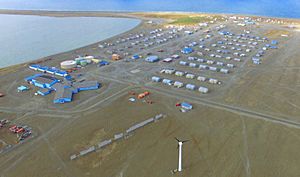
Aerial view of Gambell in 2017
|
|
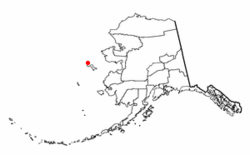
Location of Gambell, Alaska
|
|
| Country | United States |
| State | Alaska |
| Census Area | Nome |
| Incorporated | December 12, 1963 |
| Area | |
| • Total | 28.42 sq mi (73.61 km2) |
| • Land | 10.51 sq mi (27.21 km2) |
| • Water | 17.91 sq mi (46.40 km2) |
| Elevation | 0 ft (0 m) |
| Population
(2010)
|
|
| • Total | 681 |
| • Density | 60.92/sq mi (23.52/km2) |
| Time zone | UTC-9 (Alaska (AKST)) |
| • Summer (DST) | UTC-8 (AKDT) |
| ZIP code |
99742
|
| Area code | 907 |
| FIPS code | 02-27640 |
| GNIS feature ID | 1402463, 2419389 |
Gambell (pronounced GAM-bull) is a small city in Alaska, a state in the United States. It is located in the Nome Census Area. Gambell is found on St. Lawrence Island and had about 681 people living there in 2010.
Contents
History of Gambell
The local name for Gambell and St. Lawrence Island is Sivuqaq. This name comes from the Yupik language. The island has also been called Chibuchack and Sevuokok in the past.
St. Lawrence Island has been home to people for about 2,000 years. Both Alaskan and Siberian Yupik people have lived there. In the 1700s and 1800s, about 4,000 people lived on the island.

Between 1878 and 1880, a terrible famine hit the island. Many people died from hunger, and others left. After this, most of the people remaining on St. Lawrence Island were Siberian Yupik.
In 1887, a church group called the Reformed Episcopal Church started a mission. They sent a carpenter to Sivuqaq to build a wooden building. This was the first wooden building the local Yupik people had ever seen.
The church couldn't find missionaries to live on the island. So, the building stayed empty for a while. In 1890, a man named Sheldon Jackson took over the building. He asked Reverend Vene and Nellie Gambell to move to the island.
The Gambells arrived in 1894. Vene Gambell worked as a schoolteacher. They had a daughter in 1897. Nellie Gambell became sick, so they went back to the United States for a winter. In 1898, they were returning to St. Lawrence Island when their ship sank in a storm. The Gambells and their daughter were among the 37 people who drowned. After their death, Sivuqaq was renamed Gambell to honor them.
Cold War Incident
On June 22, 1955, during the Cold War, a US Navy plane was flying over the Bering Straits. Two Soviet planes attacked it. The US plane crashed near Gambell.
Local people from Gambell quickly rescued the crew. Some crew members were hurt by the attack, and others were injured in the crash. The Soviet government later said they were sorry about the incident. They even offered to pay for half of the damages. This was unusual for them during the Cold War.
In 1971, Gambell and another town called Savoonga gained ownership of most of St. Lawrence Island. This happened through the Alaska Native Claims Settlement Act.
Another event, known as the Gambell incident, happened on February 27, 1974. A Soviet ice reconnaissance plane landed in Gambell by mistake.
On August 30, 1975, a plane called Wien Air Alaska Flight 99 crashed while trying to land in Gambell. Ten people died in that accident.
In October 2022, two people from Russia arrived in Gambell by boat. They asked for help because they wanted to avoid military service in their home country. This was a very unusual journey.
Geography and Climate
Gambell is located on the northwest tip of St. Lawrence Island. This island is in the Bering Sea. Gambell is about 325 kilometers (202 miles) southwest of Nome. It is also only about 58 kilometers (36 miles) from Chukotka in Russia.
The city covers an area of about 78.7 square kilometers (30.4 square miles). Most of this area, about 50.5 square kilometers (19.5 square miles), is water. The town has its own airport, called Gambell Airport.
Weather in Gambell
Gambell has a polar climate. This means it has long, very cold, and snowy winters. The summers are short and cool. The nearby cold Bering Sea makes the weather change slowly between seasons. For example, April is usually colder than December.
Even though it's a polar climate, Gambell is not as cold as some other places at the same latitude. This is because of the ocean's influence. The ground here has discontinuous permafrost, meaning it's not frozen solid everywhere.
| Climate data for Gambell (1961–1990 normals, extremes 1936–1988) | |||||||||||||
|---|---|---|---|---|---|---|---|---|---|---|---|---|---|
| Month | Jan | Feb | Mar | Apr | May | Jun | Jul | Aug | Sep | Oct | Nov | Dec | Year |
| Record high °F (°C) | 39 (4) |
41 (5) |
36 (2) |
45 (7) |
54 (12) |
64 (18) |
71 (22) |
68 (20) |
62 (17) |
53 (12) |
54 (12) |
42 (6) |
71 (22) |
| Mean maximum °F (°C) | 30.2 (−1.0) |
25.0 (−3.9) |
30.0 (−1.1) |
32.3 (0.2) |
43.9 (6.6) |
54.5 (12.5) |
62.9 (17.2) |
58.1 (14.5) |
50.9 (10.5) |
41.7 (5.4) |
35.6 (2.0) |
34.3 (1.3) |
63.7 (17.6) |
| Mean daily maximum °F (°C) | 11.6 (−11.3) |
6.4 (−14.2) |
9.8 (−12.3) |
18.9 (−7.3) |
33.6 (0.9) |
44.0 (6.7) |
50.7 (10.4) |
49.7 (9.8) |
43.5 (6.4) |
33.7 (0.9) |
24.8 (−4.0) |
18.6 (−7.4) |
28.9 (−1.7) |
| Daily mean °F (°C) | 7.1 (−13.8) |
1.4 (−17.0) |
5.4 (−14.8) |
13.2 (−10.4) |
29.6 (−1.3) |
39.1 (3.9) |
46.5 (8.1) |
46.1 (7.8) |
40.4 (4.7) |
30.7 (−0.7) |
22.8 (−5.1) |
15.6 (−9.1) |
25.9 (−3.4) |
| Mean daily minimum °F (°C) | 3.7 (−15.7) |
−1.4 (−18.6) |
0.7 (−17.4) |
8.8 (−12.9) |
25.2 (−3.8) |
34.2 (1.2) |
41.5 (5.3) |
41.7 (5.4) |
36.6 (2.6) |
28.2 (−2.1) |
19.1 (−7.2) |
11.5 (−11.4) |
20.9 (−6.2) |
| Mean minimum °F (°C) | −13.7 (−25.4) |
−17.3 (−27.4) |
−13.2 (−25.1) |
−7.3 (−21.8) |
14.9 (−9.5) |
28.2 (−2.1) |
35.6 (2.0) |
35.1 (1.7) |
28.7 (−1.8) |
18.7 (−7.4) |
4.7 (−15.2) |
−6.8 (−21.6) |
−19.7 (−28.7) |
| Record low °F (°C) | −24 (−31) |
−26 (−32) |
−26 (−32) |
−20 (−29) |
2 (−17) |
21 (−6) |
30 (−1) |
30 (−1) |
24 (−4) |
13 (−11) |
−7 (−22) |
−20 (−29) |
−26 (−32) |
| Average precipitation inches (mm) | 0.89 (23) |
0.79 (20) |
1.04 (26) |
0.71 (18) |
0.88 (22) |
0.66 (17) |
0.92 (23) |
1.87 (47) |
1.52 (39) |
1.52 (39) |
1.53 (39) |
1.79 (45) |
14.12 (359) |
| Average snowfall inches (cm) | 2.3 (5.8) |
3.0 (7.6) |
1.2 (3.0) |
5.4 (14) |
3.3 (8.4) |
0.1 (0.25) |
0.0 (0.0) |
0.0 (0.0) |
0.3 (0.76) |
2.2 (5.6) |
4.2 (11) |
4.0 (10) |
26.0 (66) |
| Average precipitation days (≥ 0.01 inch) | 8.0 | 6.3 | 4.7 | 8.5 | 5.4 | 4.0 | 6.7 | 10.3 | 11.0 | 11.2 | 11.3 | 15.3 | 102.7 |
| Average snowy days (≥ 0.01 inch) | 5.3 | 5.8 | 2.8 | 7.5 | 3.6 | 0.3 | 0.0 | 0.0 | 0.1 | 2.7 | 8.1 | 10.2 | 46.4 |
| Source 1: Western Regional Climate Center | |||||||||||||
| Source 2: XMACIS (snowfall) | |||||||||||||
Population and Education
Gambell first appeared in the U.S. Census in 1910. It officially became a city in 1963.
| Historical population | |||
|---|---|---|---|
| Census | Pop. | %± | |
| 1910 | 221 | — | |
| 1920 | 48 | −78.3% | |
| 1930 | 250 | 420.8% | |
| 1940 | 296 | 18.4% | |
| 1950 | 309 | 4.4% | |
| 1960 | 358 | 15.9% | |
| 1970 | 372 | 3.9% | |
| 1980 | 445 | 19.6% | |
| 1990 | 525 | 18.0% | |
| 2000 | 649 | 23.6% | |
| 2010 | 681 | 4.9% | |
| U.S. Decennial Census 2010 | |||
In the 2020 census, there were 640 people living in Gambell.
Schools in Gambell
The Bering Strait School District serves Gambell. Gambell School teaches students from Pre-Kindergarten all the way to 12th grade.
Students from Gambell have done very well in national competitions. In 1984, two teams of students won national championships in a program called Future Problem Solving.
More recently, in 2023, a team of junior high students (grades 6-8) won an award. They received the Blade Engineer Award at the National KidWind Challenge. This competition was held in Boulder, Colorado.
See also
 In Spanish: Gambell (Alaska) para niños
In Spanish: Gambell (Alaska) para niños



